8 Best Nikon Binoculars of 2025 – Reviews & Top Picks
Last Updated on
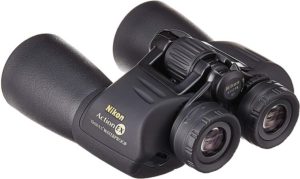
Nikon is famous for its high-quality, well-designed binoculars and cameras. Whether you’re looking for an inexpensive, highly portable model or a high-end, high-powered option, Nikon can meet your needs. But the company sells dozens of binocular models, so how do you choose the best one for you?
To help you shop for a great pair of Nikon binoculars, we tested the available models and put together this ranked list of the eight best Nikon binoculars. For each model, we’ve written a comprehensive review, comparing price, magnification, lens quality, focus distance, warranty, and more so you can feel confident in your choice. No matter what you’re looking for, there’s a great pair of Nikon binoculars waiting for you!

A Quick Glance at Our Favorites in 2025
| Image | Product | Details | ||
|---|---|---|---|---|
| Best Overall |
 |
Nikon 7245 |
|
CHECK PRICE |
| Best Value |
 |
Nikon ACULON A30 |
|
CHECK PRICE |
| Premium Choice |
 |
Nikon 7577 Monarch 5 |
|
CHECK PRICE |
 |
Nikon 8252 ACULON A211 |
|
CHECK PRICE | |
 |
Nikon 6977 Prostaff 3S |
|
CHECK PRICE |
The 8 Best Nikon Binoculars
1. Nikon 7245 All-Terrain Binocular – Best Overall
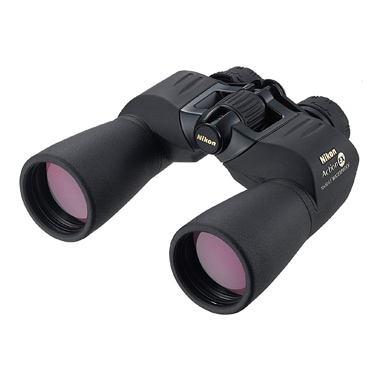
Our overall top pick is the Nikon 7245 Action EX Extreme All-Terrain Binocular. These lightweight binoculars are weatherproof, durable, and powerful, with plenty of magnification and a very fair price.
At 2.5 pounds, these waterproof, fog-proof binoculars are on the heavier end. They offer 10 times magnification through multi-coated 50-millimeter objective lenses. The close focus distance is 23 feet, and there are adjustable rubber eyecups and a straightforward central focus knob. The lenses are made of dense, high-quality BAK-4 prism glass, and the body has a durable rubber coating. The package includes a carrying case, strap, and lens covers.
When we tested these binoculars, we found them to be very effective and simple to use. The lens covers are somewhat difficult to take off and put on, and the close focus distance is farther away than many other models. Nikon offers a great lifetime warranty.
- Reasonably priced
- Waterproof and fog-proof
- 10 times magnification and 50-millimeter objective lenses
- Multi-coated, high-quality BAK-4 prism glass
- Adjustable eyecups and central focus knob
- Includes carrying case, strap, and lens covers
- Generous lifetime warranty
- Somewhat heavy
- Close focus distance of 23 feet
- Lens covers are more difficult to use
2. Nikon ACULON A30 Binocular – Best Value
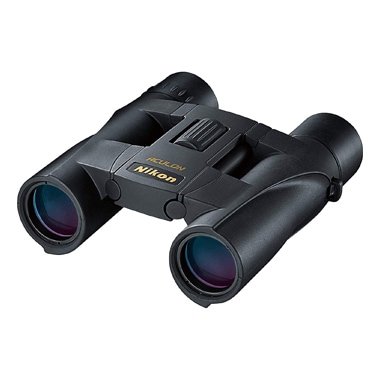
If you’re shopping on a budget, check out the Nikon ACULON A30 Binocular, which we found to be the best Nikon binoculars for the money.
These compact 9.7-ounce binoculars, which offer 10 times magnification through small 25-millimeter objective lenses, are reasonably powerful and easy to carry. The close focus distance is a mere 8.2 feet, and there’s a simple central focus knob. The multi-coated lenses are made of high-quality BAK-4 prism glass, and the package includes a streamlined case, eyepiece caps, and a carrying strap. We were impressed with the wide field of vision, which was around 260 feet at 1,000 yards.
Low-cost and streamlined, these binoculars are a great value buy. However, they have a cheaper feel and aren’t quite as durable. They’re not waterproof and don’t include objective lens caps. With small lenses, they don’t work as well in low light. Nikon offers its generous lifetime warranty.
- Inexpensive and very lightweight
- 10 times magnification with 25-millimeter lenses
- Multi-coated BAK-4 prism lenses
- Central focus knob
- Close focus distance of 8.2 feet
- Wide field of vision
- Includes streamlined case, strap, and eyepiece caps
- Lifetime warranty
- Narrow objective lenses
- Don’t work as well in low light
- Somewhat cheap-feeling
- Less durable and not waterproof
- No included objective lens caps
3. Nikon 7577 MONARCH Binocular – Premium Choice
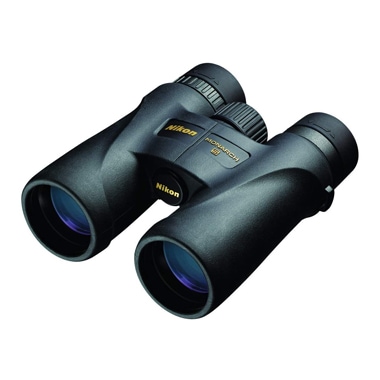
If you’re willing to spend a bit more, you may appreciate the added features of the Nikon 7577 MONARCH 5 Binocular. This high-end model has wide lenses, effective fog-proofing, and a very durable feel.
These pricey binoculars weigh a fairly light 1.35 pounds and offer 10 times magnification with wide 42-millimeter objective lenses. They have multi-coated lenses made of extra-low dispersion glass, plus convenient features like slide-adjusting rubber eyecups, a central focus knob, and flip-down lens caps. They’re nitrogen-filled and sealed with O-rings for full water- and fog-proofing. The package includes a soft case and a strap, plus objective and eyepiece lens caps.
These binoculars feel solidly built and durable, though they’re somewhat bulky and quite expensive. The strap assembly isn’t very sturdy, and the focus can be difficult to adjust. Though the objective lens caps work well, the eyepiece caps fit loosely and may fall off. Nikon offers its great lifetime warranty.
- 10 times magnification and wide 42-millimeter objective lenses
- Fairly lightweight
- Multi-coated, low dispersion glass lenses
- Slide-adjusting rubber eyecups, central focus knob, and flip-down lens caps
- Water- and fog-proof, with nitrogen purging and O-ring seals
- Includes soft case, strap, objective and eyepiece lens caps
- Lifetime warranty
- More expensive
- Bulky, with a less durable strap assembly
- Focus can be difficult to adjust
- Loose-fitting eyepiece caps
4. Nikon 8252 ACULON Binocular
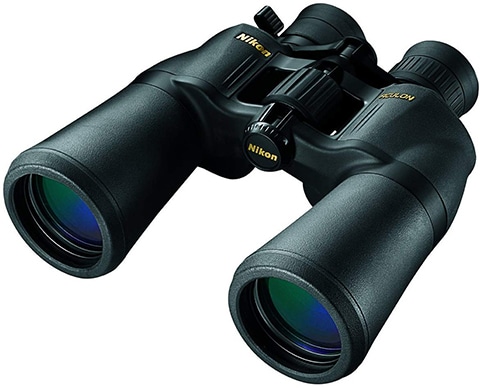
The Nikon 8252 ACULON A211 Zoom Binocular is a pricey, somewhat heavy option that offers strong magnification but doesn’t feel as durable.
These two-pound binoculars offer an impressive 22 times magnification and have wide 50-millimeter objective lenses. There’s a simple fingertip zoom control knob, plus turn and slide adjustable rubber eyecups and durable armored rubber coating. The minimum focus distance is 49.2 feet, and the high-quality BAK-4 prism glass lenses are multi-coated. The package includes a soft case and a strap.
When we tested them, we found that these binoculars didn’t focus well at high magnification levels, and there was some distortion. They also didn’t feel particularly durable. Nikon offers its lifetime warranty.
- 22 times magnification and wide 50-millimeter objective lenses
- Fingertip zoom control and adjustable rubber eyecups
- Multi-coated BAK-4 prism lenses
- Includes soft case and strap
- Lifetime warranty
- More expensive and somewhat heavy
- Minimum focus distance of 49.2 feet
- Not especially durable
- Doesn’t focus well at high magnification
- Some distortion
5. Nikon 6977 Prostaff 3s Binocular
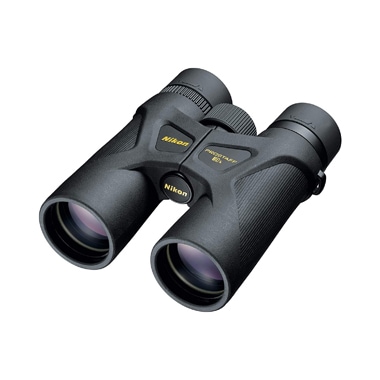
Nikon’s 6977 Prostaff 3s Binocular is surprisingly pricey given its fairly limited features and inability to work in low light.
These 1.2-pound binoculars offer 10 times magnification, with 42-millimeter objective lenses. There are turn and slide adjustable rubber eyecups, and the body is coated in durable armored rubber. These binoculars are nitrogen-filled and O-ring sealed, making them fully waterproof and fog-proof. The silver-alloy mirror-coated lenses are multi-coated and made of eco glass. The package includes a case, lens caps, and straps.
Overall, we found these binoculars to be more expensive than their features justified. For the price, they have low magnification, and they don’t work as well at night and in other low light settings. These binoculars are backed by Nikon’s lifetime warranty.
- Fairly lightweight
- 10 times magnification with 42-millimeter lenses
- Waterproof and fog-proof, with nitrogen purging
- Silver-alloy mirror-coated lenses
- Adjustable eyecups
- Includes case, lens caps, and straps
- Lifetime warranty
- More expensive
- Don’t work as well in low light
6. Nikon NIK-8218 Waterproof Binoculars
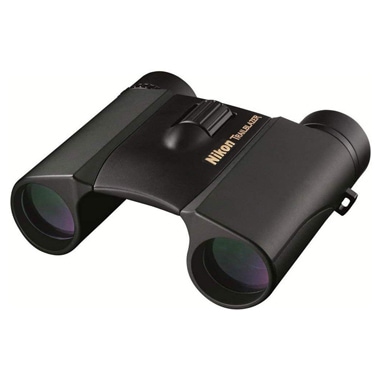
The Nikon NIK-8218 Trailblazer ATB Waterproof Binoculars are inexpensive and lightweight but also have a cheaper feel.
These compact 9.9-ounce binoculars offer 10 times magnification and have smaller 25-millimeter objective lenses. The body has a durable rubber coating, and there’s a simple central focus knob, plus a close focus distance of 11.5 feet. The multi-coated lenses are made of high-quality BAK-4 prism glass, and the interior is nitrogen-filled and water- and fog-proof.
We found these binoculars to have a cheaper feel, with a somewhat stiff focus knob and limited magnification power. Nikon offers its lifetime warranty.
- Lightweight and fairly inexpensive
- Nitrogen-filled and water- and fog-proof
- 10 times magnification
- Durable rubber coating
- Multi-coated BAK-4 prism lenses
- Close focus of 11.5 feet
- Central focus knob
- Lifetime warranty
- Small 25-millimeter lenses
- Cheaper feel overall
- Stiff focus knob
7. Nikon 16006 Monarch 3 Binoculars
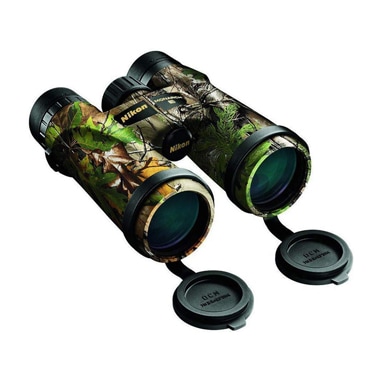
Nikon’s 16006 Monarch 3 Binoculars are expensive but offer very low magnification and come with less durable accessories.
The 1.5-pound binoculars, sold in a distinctive camo print, have very limited eight times magnification with 42-millimeter objective lenses. There are adjustable eyecups, and the close focus distance is just 9.8 feet. These binoculars are water- and fog-proof, with nitrogen purging. There’s a smooth central focus knob, and the lenses have a convenient silver-alloy coating. The package includes a case, neck strap, and lens cap.
We found the case to be less protective, and the neck strap didn’t feel as durable. This model’s high price point is hard to justify, given the low magnification. Nikon’s lifetime warranty applies.
- Nitrogen-filled and water- and fog-proof
- Wide 42-millimeter objective lenses
- Smooth central focus knob and adjustable eyecups
- Silver-alloy coating on lenses
- Close focus of 9.8 feet
- Includes case, neck strap, and lens cap
- Lifetime warranty
- More expensive
- Only sold in a camo design
- Low eight times magnification
- Less protective case
8. Nikon 7279 Travelite Binoculars

Our least favorite option is Nikon’s 7279 Travelite Binoculars. These mid-range binoculars are lightweight but don’t produce a very clear image and have a somewhat cheap feel.
At 9.7 ounces, this model is highly portable. It offers 12 times magnification, with small 25-millimeter objective lenses. The multi-coated BAK-4 prism lenses are aspherical, designed to produce less distortion and increase image sharpness. There’s a click-type diopter adjustment ring, and the rubber eyecups can flatten. The package includes a travel case, straps, and lens covers, and the close focus distance is a reasonable 13 feet.
When we tested these binoculars, we found them to produce a slightly blurred image. They have a cheaper feel, and the rubber eyecups don’t work especially well with prescription glasses. Nikon backs these binoculars with its lifetime warranty.
- Mid-range and very portable
- 12 times magnification
- Multi-coated BAK-4 prism lenses
- Aspherical design for less distortion
- Click-type diopter adjustment ring
- Rubber eyecups can flatten
- Includes travel case, straps, and lens covers
- 13-foot close focus distance
- Lifetime warranty
- Small 25-millimeter lenses
- Somewhat distorted, slightly blurred image
- Cheaper feel overall
- Eyecups don’t work well with glasses

Buyer’s Guide: Finding the Best Nikon Binoculars
You’ve read through our list of best Nikon binoculars, but which model should you choose? They may seem similar, but each type of binoculars has a unique combination of features. Keep reading to learn all about those features.
Size
Will you be carrying your binoculars on lengthy hikes, or will you use them from home or your car? Consider how portable your binoculars will need to be. Large binoculars may provide better magnification, but will also be bulky, heavy, and more difficult to carry. The binoculars we’ve reviewed here range from a few ounces up to 2.5 pounds.
Price
How much are you willing to spend to get the best Nikon binoculars? You can get a good model for less than a hundred dollars, but if you have a larger budget, you may appreciate the added features of a premium model.
Specifications
The most important specifications for binoculars are the magnification level and the lens diameter. You can find these numbers on the top of each pair of binoculars, written as magnification x diameter. A good mid-range magnification level is 10 times, but if you’d like to see things that are very far away, you may prefer a magnification closer to 20 times.
Are you looking for long-distance binoculars? Take a look at our guide to the best high-power binoculars available this year.
The diameter specification refers to the width of the objective lenses. Measured in millimeters, this number will determine how much light can enter your binoculars. If you’d like to use your binoculars for stargazing or in other low-light settings, you’ll probably want wider lenses, around 42 millimeters. If you’ll be using your binoculars in daylight and would prefer high portability, you may prefer smaller lenses, around 25 millimeters.
Another key number is the close focus distance, which will determine the minimum distance at which your binoculars will focus. If you’d like to magnify closer objects, you may want binoculars that can focus at under 10 feet. If you’re buying long-distance binoculars, you may be fine with a significantly higher minimum focus distance.
Lenses
The highest quality lens glass is BAK-4, which is high-density and produces less distortion, particularly around the edges and in low light.
Lens coatings affect how well you can see through your binoculars. High-quality binoculars have multi-coated lenses that have been treated in several ways to prevent glare, chromatic aberrations, and other distortions. All of Nikon’s binoculars have multi-coated lenses.
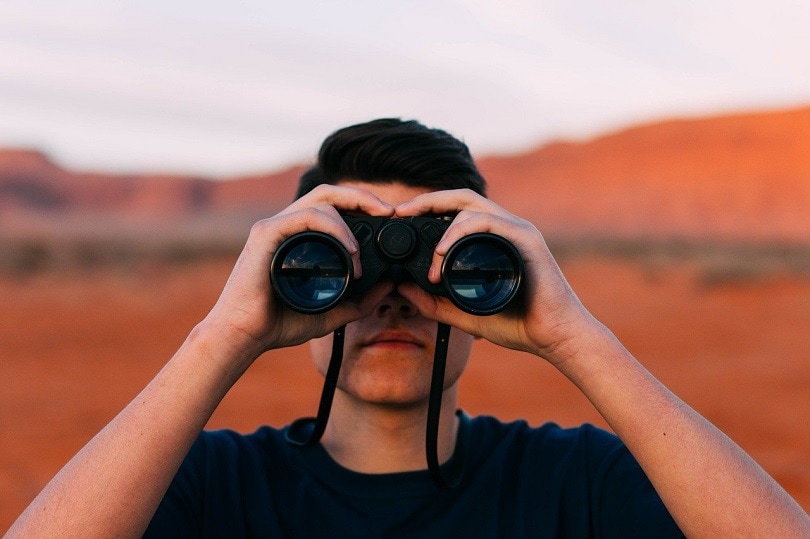
Accessories
The best Nikon binoculars generally come with a good range of accessories, like carrying cases, neck-straps, and lens covers. The higher-end models may include caps for the eyepiece and objective lenses, offering additional protection.
Weather Proofing
All of these binoculars feature durable, water-resistant rubber coating, which is also slip-proof. Nikon’s high-end binoculars have additional weather protection like water- and fog-proof interiors, which have been filled with nitrogen and sealed with O-rings. This process keeps the binoculars from fogging up inside.
Warranty
All of Nikon’s binoculars are protected by a generous lifetime warranty. This warranty covers all of the components of the optical system, which Nikon will replace or repair for free. There’s also a seven-year warranty covering non-optical components. These warranties are non-transferable, so if you purchase a used pair, it may not come with a warranty.

Conclusion
The results are in! Our favorite model is the Nikon 7245 Action EX Extreme All-Terrain Binocular, which is well-designed, weather-proof, and powerful. Are you looking for a budget option? You may want to try the compact Nikon ACULON A30 Binocular, which offers plenty of functionality at a very reasonable price. Are you willing to spend more? You may like the high-end Nikon 7577 MONARCH 5 Binocular, which offers extra features and a useful range of accessories.
From the great warranty to the excellent weather-proofing, Nikon is a good option for high-quality binoculars. But with so many models and options, you may not know which to choose. We hope this list of the eight best Nikon binoculars available this year, complete with detailed reviews and a quick buyer’s guide, helps you quickly and confidently choose a great model. You’ll be spotting eagles, whale watching, or stargazing in no time!
Table of Contents
- A Quick Glance at Our Favorites in 2025
- The 8 Best Nikon Binoculars
- 1. Nikon 7245 All-Terrain Binocular – Best Overall
- 2. Nikon ACULON A30 Binocular – Best Value
- 3. Nikon 7577 MONARCH Binocular – Premium Choice
- 4. Nikon 8252 ACULON Binocular
- 5. Nikon 6977 Prostaff 3s Binocular
- 6. Nikon NIK-8218 Waterproof Binoculars
- 7. Nikon 16006 Monarch 3 Binoculars
- 8. Nikon 7279 Travelite Binoculars
- Buyer’s Guide: Finding the Best Nikon Binoculars
- Conclusion
About the Author Robert Sparks
Robert’s obsession with all things optical started early in life, when his optician father would bring home prototypes for Robert to play with. Nowadays, Robert is dedicated to helping others find the right optics for their needs. His hobbies include astronomy, astrophysics, and model building. Originally from Newark, NJ, he resides in Santa Fe, New Mexico, where the nighttime skies are filled with glittering stars.
Related Articles:
When Were Binoculars Invented? History, Today & Future
How to Collimate Binoculars: 9 Expert Tips
Binocular Magnification Chart: Numbers & Distances Compared
What Is the Best Binocular Magnification for Hunting? Optical Features Explained
Can You Use Binoculars to Look At Stars? How to Choose the Right Pair
How to Choose Binoculars for Bird Watching: 10 Expert Tips
What Does 20X50 Mean on Binoculars? Our Helpful Guide
10 Best Binoculars in Canada of 2024: Reviews & Top Picks



